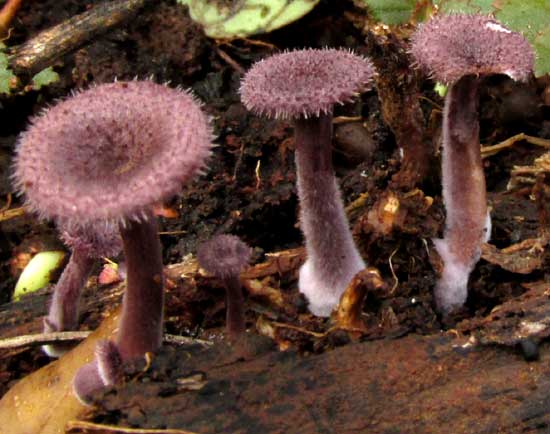Excerpts from Jim Conrad's
Naturalist Newsletter
from the May 31, 2018 Newsletter issued from Rancho Regenesis in the woods ±4kms west of Ek Balam Ruins; elevation ~40m (~130 ft), N~20.876°, W~88.170°; central Yucatán, MÉXICO
HAIRY PANUS
Most of the year the Yucatan is too arid to produce many mushrooms, but now with the advent of the rainy season occasionally some nice ones show up. For example, this week a pretty one emerged from the rotting wood of one of my plant beds, shown below:

The flesh was soft and pliable, and the caps were notable for their depressed or sunken centers, their being covered with short hairs and dark-tipped scales, and for their slightly violet color. Below, you can see another important feature for identification, along with my thumb tip indicating the size:

Notice how the gills extend partway down the stems, which are a little bulbous toward their bases. Having such gills separates this species from most gilled fungi, and directs us toward the vicinity of the famously edible Chanterelles we used to eat so many of back in Mississippi. You can see the present species' similarity to the Mississippi Chanterelles at www.backyardnature.net/n/x/cibarius.htm
The violet color barely detectable in these mature mushrooms manifests much more intensely in immature one right beside those shown above, as you can see below:

Having all that information and an obviously distinctive mushroom, now the frustration begins. For, the fungi simply are not much known in this part of the world, and no effective means exist to identify them. The problem is exacerbated by the fact that fungal spores travel enormous distances on wind, so even the rarest species might turn up in unexpected places.
UPDATE: Years later, with the online iNaturalist becoming ever more helpful, the AI identification feature helps identify this as what's often called the Hairy Panus, PANUS LECOMTEI, distributed nearly worldwide, but rarely noted in Mexico, most frequently in eastern North America and Europe.
The 2020 study by V.P. Sharma and others entitled "Nutritional and Biochemical Characterization of Panus lecomtei Mushroom (Agaricomycetes) from India and Its Cultivation," tells us that the species contains a substantial amount of useful nutritional and medicinal compounds, and is promoted as a potential edible mushroom for the diversification of mushroom production.